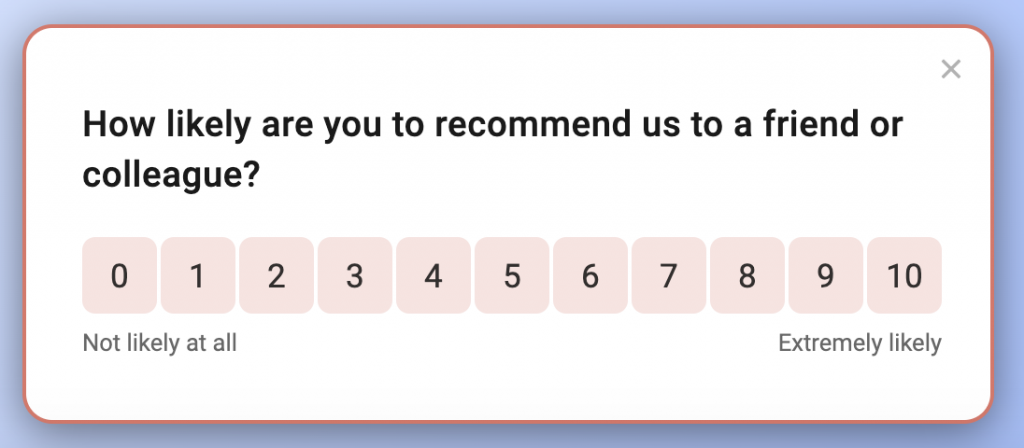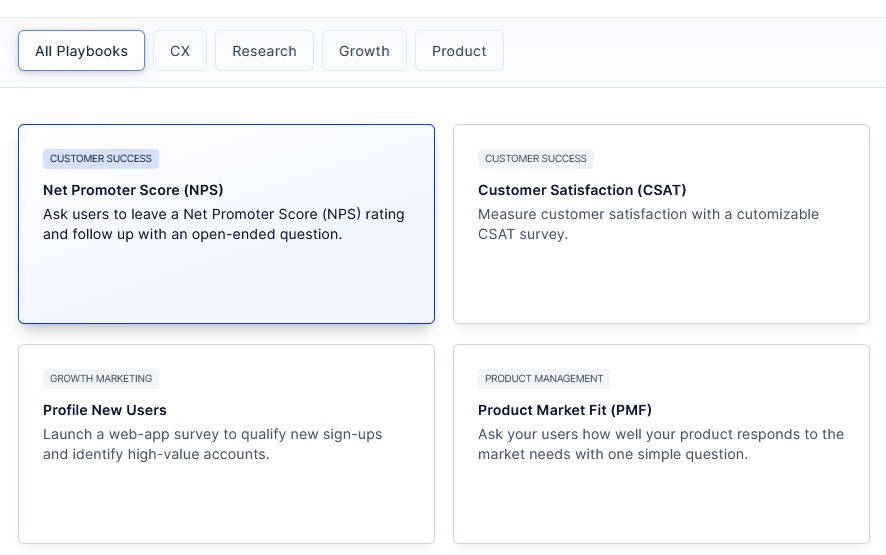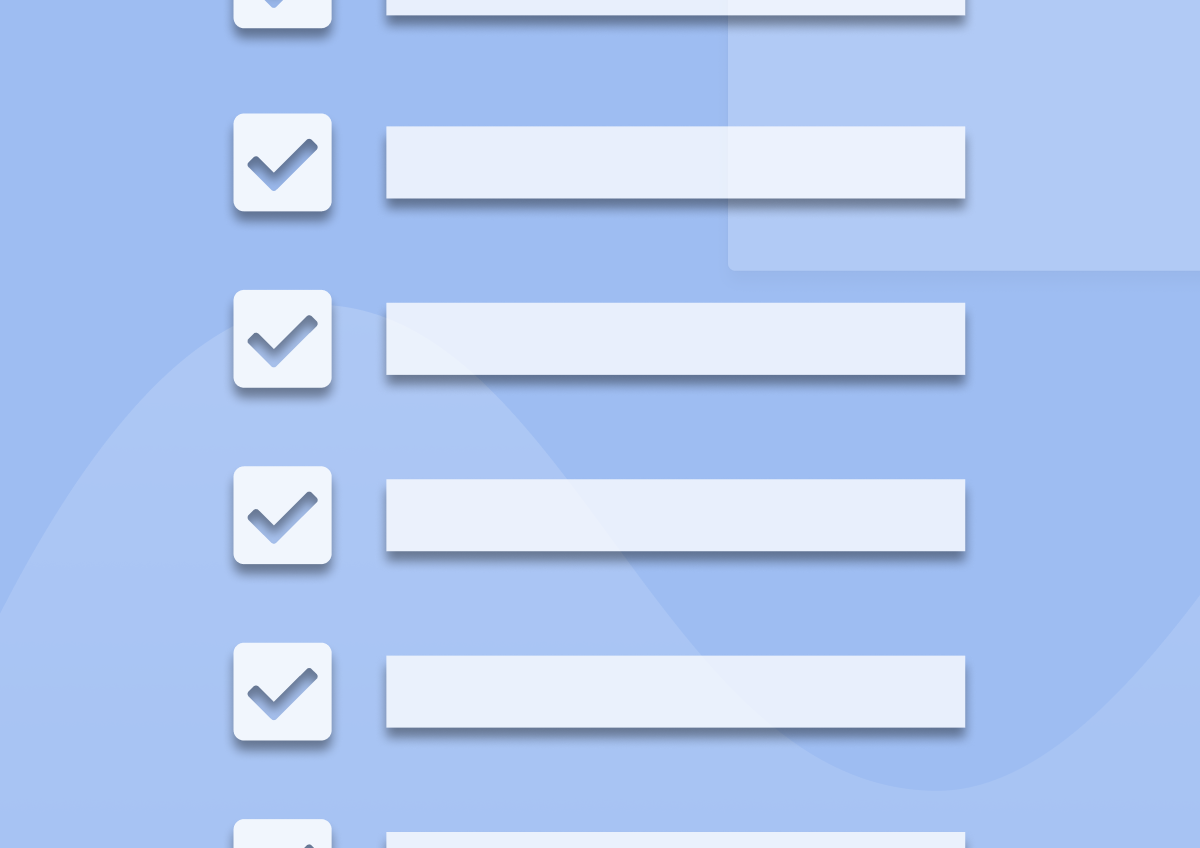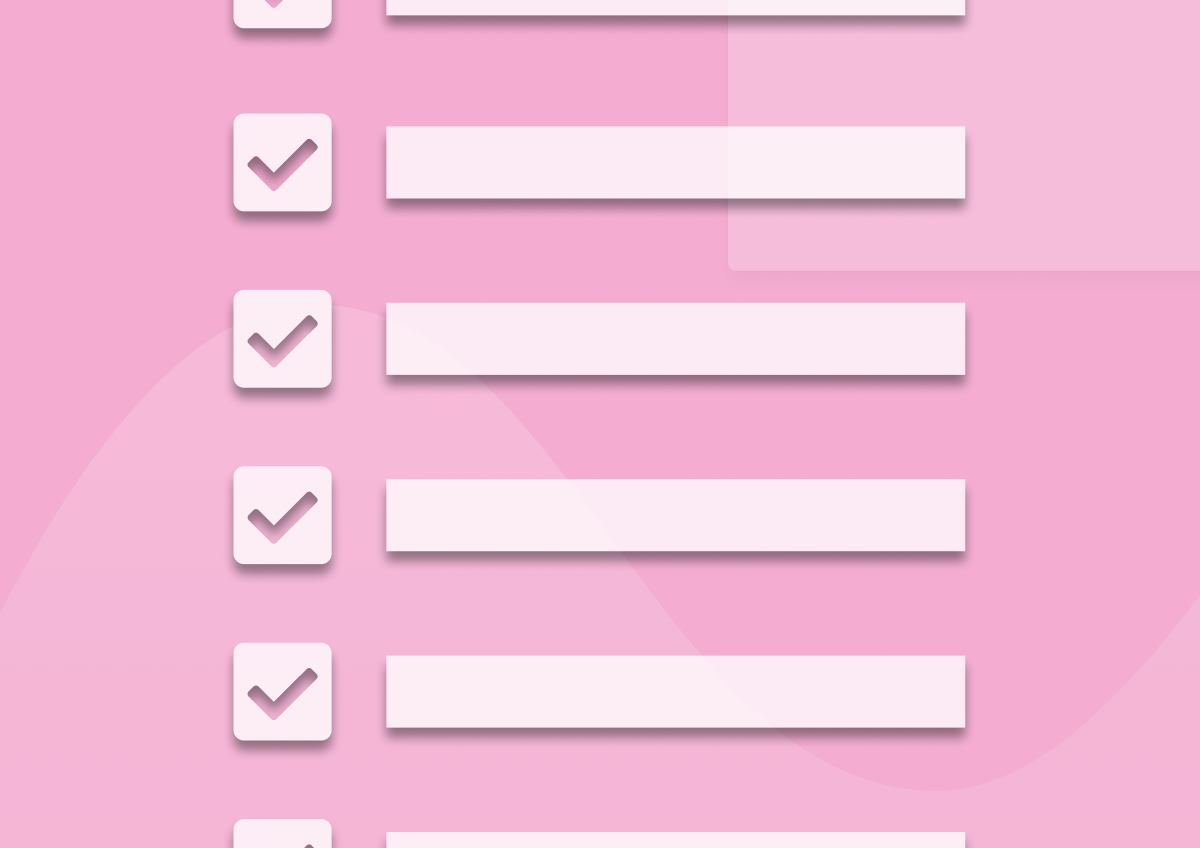7 NPS Questions That Will Deliver Incredible Insights (with Examples)
This is the ultimate list of the best NPS questions that you should be asking.
Fact: NPS is an amazing method to assess customer loyalty and satisfaction. Even a simple survey can help you evaluate how well your company is satisfying customers’ needs, and in turn, how likely they are to recommend you to others.
Like this:

But there is a problem, too.
At first sight, NPS seems quite simple.
It’s only when you try to come up with NPS questions to ask, particularly ones that relate to your business, you realize that getting the right insights from NPS surveys requires more than asking basic questions.
Hence this guide.
On this page, you’ll discover the different types of NPS survey questions to ask. You’ll also see actual examples of various NPS surveys and those questions in use. You’ll also learn why they’ve worked, and what insights you could get by using those methods.
In short, after reading this guide, you’ll be able to design an NPS survey that will deliver the insights you seek.
So, let’s begin.
How NPS Surveys Work
An NPS survey is a question-based technique that helps evaluate what’s known as the Net Promoter Score – a metric indicating the likelihood of a user promoting and advocating your brand.
Such a survey, typically, consists of two questions.
The first one asks users or customers to rate, on a scale of 0 to 10, your business, product, service, or anything else about your business that you’re evaluating. We refer to it as the rating question as a result.
The purpose of the rating question is to assess your customer base and discover, in percentages, where they fall into three categories:
- Detractors,
- Passives, and
- Promoters.
However, the other question aims to uncover the reasons why a person has scored you the way they had. In this case, you’re asking a follow-up, open-ended question relating to the category a person has fallen because of their score.
Worth to note: I often see companies paying the most attention to their rating question. Now, I admit that it’s an important one. But it’s the follow-up that can make or break your NPS survey. Why, because it is your chance to gain an incredibly in-depth insight into why a person scored your brand the way they did.
But of course, the follow-up question depends on the type of information you’d like to collect.
SaaStock, for example, uses the NPS score to evaluate their attendants’ likelihood of recommending the company and its conference to their peers.

But the company asks only a basic follow-up question.

It, most likely, makes sense for them. However, I always recommend considering the follow-up question thoroughly. As said, it can make or break the insights you’re going to receive.
NPS Questions and Examples
To recap what we’ve discussed so far – To run a successful NPS survey, you need to ask two questions:
- A rating question aimed at evaluating your brand, product, or service on a scale of 0-10.
- A follow-up question to dig deeper into a person’s reasoning for scoring you the way they did.
But what makes a good rating question, and how to construct a follow-up that can deliver meaningful insights?
Well, let’s look at those in turn.
PRO TIP: Refiner comes loaded with ready-made survey templates, including NPS, that let you create a survey with the most relevant questions within seconds.

Part I. Examples of NPS Rating Questions
#1. Asking about the likelihood of a referral from the person
Let’s start with the most common NPS survey question, which I am sure you have seen many times before.
The question goes:
“On a scale of 0 to 10, how likely are you to recommend us to a friend or colleague?”

The question asks for a simple opinion. It is an ideal question to use to measure your overall customers’ satisfaction with you or your product.
What’s more, the answers you collect can give you an overview of your user base’s sentiment towards your product or brand.
With this question, you can evaluate how deeply ingrained your product is in their lives and how helpful they find it. You can also find out how many unhappy customers you may have in the user base and evaluate how your customers feel about the product in general.
A quick tip: Because you’re asking about a person’s general experience with using a product, this question is ideal when evaluating the sentiment about a particular product or service, rather than a company. I wouldn’t recommend using it to assess a customers’ attitudes towards a brand (unless the brand and product can be perceived as one, of course.)
#2. Asking directly about the experience with a company
The question above asked about a person’s likelihood to recommend a product in general terms. As you’ve learned already, it offered an excellent opportunity to evaluate the general sentiment towards what you sell.
But, you may want to be more specific and direct and ask a person to evaluate you based on their experiences.
In this instance, a question to ask could go like this:
“Considering your experience with [Insert Your Company Name,] how likely are you to recommend us to a friend or colleague?”

What’s unique about this question? Well, for one, the question focuses on a person’s experience with the company, rather than its product. And because of that, you can use this particular NPS question throughout an entire customer journey to get valuable feedback about the quality of the complete experience customers have with your brand.
You can use it right after signup to evaluate your sales process, for instance. In this case, the survey would help you establish how easy the process might be, from the customer’s perspective, of course.
You could also trigger the NPS survey after a person’s had some experience with your customer service team. This way, you’d evaluate their satisfaction with the help received and identify whether you need to improve the customer service you provide.
#3. Asking about a person’s experience as a customer
This question takes the opposite approach. Instead of asking about a person’s experience with the company, you evaluate how a person feels about the product after having been using it for a while.
In this instance, the NPS question would go like this:
“Based on your experience of using [PRODUCT NAME] for [LENGTH OF TIME], how likely are you to recommend it to a friend or colleague?”

Asking about product usage will help you determine the person’s overall satisfaction and the likelihood of becoming a long-term user.
Why, because, I believe, we can safely assume that only a person who’s received value from using a product and sees it as an integral part of their success would be happy to continue using it.
Part II. Examples of NPS Follow-Up Questions
NPS follow-up question helps you dig deeper and discover the person’s reasons for giving you the score they did.
And as I have said before, it is the question that can make or break your survey.
Why, well, there are two reasons. And they also shed light on how to construct this NPS question to generate the best responses.
The first reason is the free form of this open-ended question. By asking to explain an opinion, you can get the “voice of the customer” and discover entirely new insights about your business or a product.
The other reason lies in the format of the entire NPS survey. The multiple-choice rating question reveals the situation and might indicate the “why” behind those scores. The follow-up question allows you to collect hard data on it. As you’ll shortly see, you can discover what users value the most about your product. Or what they’re missing in it.
With that in mind, here are some examples of great follow-up NPS questions to ask:
#1. “What is the primary reason for your score?”
This is an ideal question to get a sense of the logic behind a person’s answer. What’s more, because of its generic nature, you’re not putting too much pressure on a person to answer in more specific terms.
#2. “Why would you NOT recommend us?”
I admit that this question might sound cheeky at first. But in truth, asking about the person’s reasons for not wanting to recommend your product can often be the only way to uncover their reasoning.
Plus, the question allows a customer to voice their issues or frustrations with the product/service. You, on the other hand, can discover areas of your product that may need improvement.
#3. “What could we have done differently to provide a better experience?”
This is another direct question that can help uncover more insights from an NPS survey. In this case, it can help you demystify areas of your business (or its particular aspects) that have caused issues to a customer.
#4. “What should we improve?”
Finally, this question is a variation of the example above. This version puts less emphasis on customers’ issues and focuses more on ideas a person might have relating to a particular process that they have found frustrating.
A Quick Note About Creating NPS Follow-up Questions
Most of the question examples I listed above have something in common. Can you see it?
Well, they focus on getting feedback from customers who have scored your company, product, or service negatively.
In fact, only the first example above relates to customers who have scored you well. The remaining four focus on what you may have done poorly, in the eyes of customers, of course.
The reason for that isn’t because there is no insight to uncover from positive scores. But it’s the negatives (or passives) among your NPS scores that can provide ideas and feedback that could help you improve the product.
Remember, one of the main reasons for running NPS surveys is to evaluate customer satisfaction. And what goes with it is that you want to discover how many users are satisfied with the product and how many might consider leaving you for another provider.
By uncovering reasons for their dissatisfaction, you can take steps to eliminate the problem and retain those customers for longer.
Key Takeaways
- NPS survey is a question-based technique that consists of two questions. The first one asks a customer to score your product or service on a scale of 0 to 10. The other, the follow-up question, aims to learn more about the reasons for a person’s score.
- The rating question revolves around asking for a person’s likelihood of recommending you to others based on their experiences with the company, product, or service. As I’ve shown you in the examples of NPS questions above, you can construct the rating question to help you evaluate every aspect of your business or product.
- The follow-up questions dig deeper and aim to uncover why a person has scored you the way they have. The question can also help you identify your business or product areas to improve to retain NPS detractors or passives for longer.









